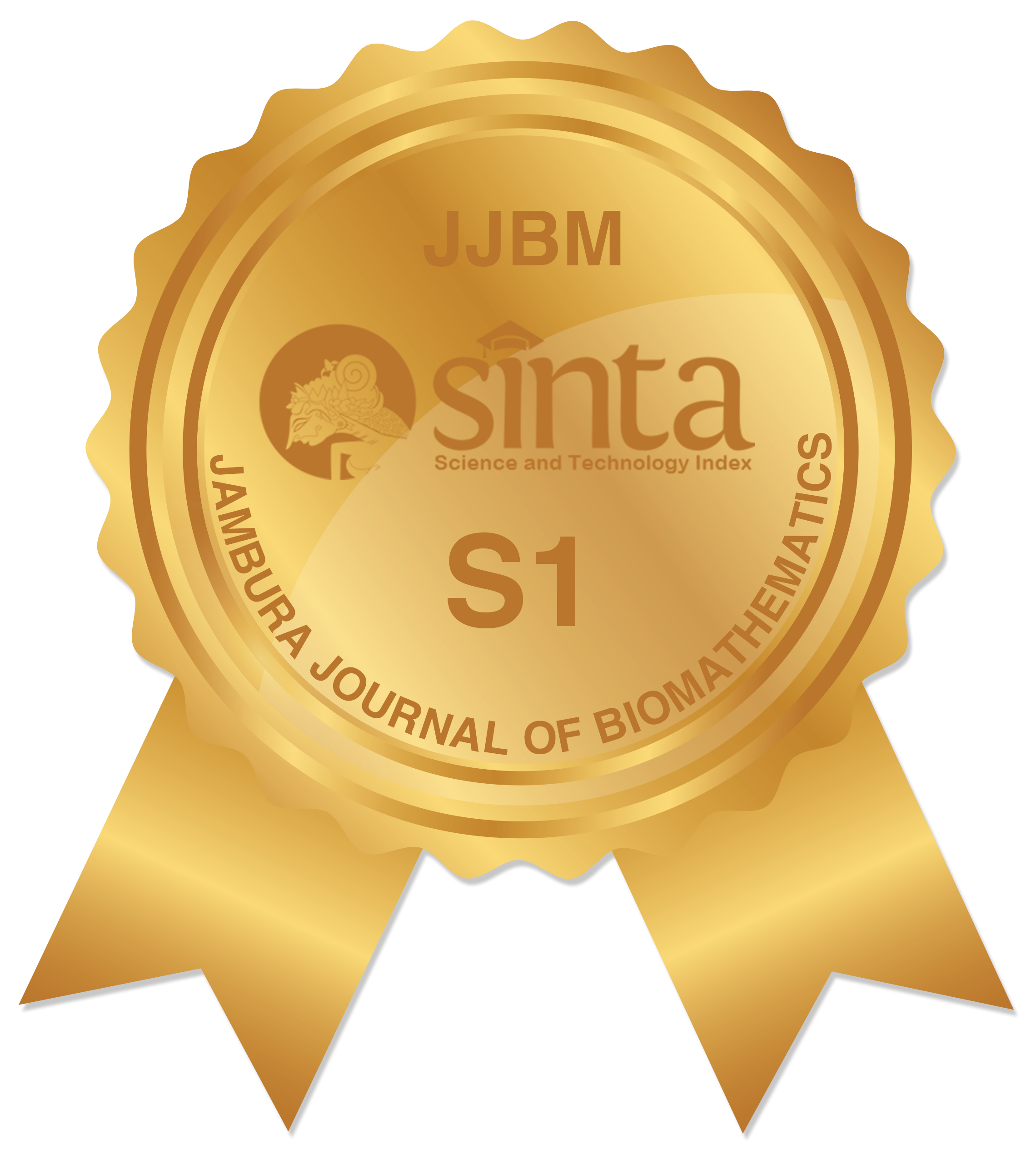Mathematical model with fractional order derivatives for Tuberculosis taking into account its relationship with HIV/AIDS and Diabetes
Abstract
Keywords
Full Text:
PDFReferences
G. Delogu, M. Sali, and G. Fadda1, "The Biology of Mycobacterium Tuberculosis Infection" Mediterranean Journal of Hematology and Infectious Diseases, vol. 5, no. 1, p. e2013070, 2013.
A. K. Niazi and S. Kalra, "Diabetes and tuberculosis: a review of the role of optimal glycemic control" Journal of Diabetes & Metabolic Disorders, vol. 11, p. 28, 2012.
C. R. Stevenson, J. A. Critchley, N. G. Forouhi, G. Roglic, B. G. Williams, C. Dye, and N. C. Unwin, "Diabetes and the risk of tuberculosis: a neglected threat to public health?" Chronic Illness, vol. 3, no. 3, pp. 228-45, 2007.
P. Baghaei, M. Marjani, P. Javanmard, P. Tabarsi, and M. R. Masjedi, "Diabetes mellitus and tuberculosis facts and controversies" Journal of Diabetes & Metabolic Disorders, vol. 12, no. 1, p. 58, 2013.
R. M. Guimarães, A. P. Lobo, E. A. Siqueira, T. F. Borges, and S. C. Melo, "Tuberculosis, HIV, and poverty: temporal trends in Brazil, the Americas, and worldwide" Jornal Brasileiro de Pneumologia, vol. 38, pp. 511-517, 2012.
L. C. de Barros, M. M. Lopes, F. S. Pedro, E. Esmi, J. P. C. dos Santos, and D. E. Sánchez, "The memory effect on fractional calculus: an application in the spread of COVID-19" Computational and Applied Mathematics, vol. 40, no. 3, p. 72, 2021.
Fatmawati, M. A. Khan, E. Bonyah, Z. Hammouch, and E. M. Shaiful, "A mathematical model of tuberculosis (TB) transmission with children and adults groups: A fractional model" AIMS Mathematics, vol. 5, no. 4, pp. 2813-2842, 2020.
M. Saeedian, M. Saeedian, M. Khalighi, Azimi-Tafreshi, and M. Ausloos, "Memory effects on epidemic evolution: The susceptible-infected-recovered epidemic model" Physical Review E, vol. 95, no. 2, p. 022409, 2017.
Fatmawati, M. A. Khan, E. Bonyah, Z. Hammouch, and E. M. Shaiful, "The fractional-order SIR and SIRS epidemic models with variable population size" Journal of the Egyptian Mathematical Society, vol. 22, no. 1, pp. 50-54, 2014.
B. B. Beatrix, D. Haydon, and K. Cuddington, Hysteresis, in book: Encyclopedia of Ecology. Elsevier Science, 2008.
T. K. Yamana, X. Qiu, and E. A. B. Eltahir, "Hysteresis in simulations of malaria transmission" Advances in Water Resources, vol. 108, pp. 416-422, 2017.
A. Pimenov, T. Kelly, A. Korobeinikov, M. O'Callaghan, A. Pokrovskii, and D. Rachinskii, "Memory effects in population dynamics: Spread of infectious disease as a case study" Mathematical Modelling of Natural Phenomena, vol. 7, no. 3, pp. 204-226, 2012.
I. Ullah, S. Ahmad, M. ur Rahman, and M. Arfan, "Investigation of fractional order tuberculosis (TB) model via Caputo derivative" Chaos, Solitons & Fractals, vol. 142, p. 110479, 2011.
S. Rosa and D. F. M. Torres, "Optimal Control and Sensitivity Analysis of a Fractional Order TB Model" Statistics, Optimization & Information Computing, vol. 7, no. 3, pp. 617-625, 2019.
M. Farman, M. Usman, A. Ahmad, and M. Ahmad, "Mathematical Analysis of Fractional Order Co-Infection TB and HIV Model" International Journal of Analysis and Applications, vol. 18, no. 1, pp. 16-32, 2020.
H. Khan, J. Gómez-Aguilar, A. Alkhazzan, and A. Khan, "A fractional order HIV-TB coinfection model with nonsingular Mittag-Leffler Law" International Journal of Analysis and Applications, vol. 43, no. 6, pp. 3786-3806, 2020.
C. M. A. Pinto and A. R. M. Carvalho, "A latency fractional order model for HIV dynamics" Journal of Computational and Applied Mathematics, vol. 312, pp. 240-256, 2020.
Fatmawati, E. M. Shaiful, and M. I. Utoyo, "A Fractional-Order Model for HIV Dynamics in a Two-Sex Population"
International Journal of Mathematics and Mathematical Sciences, vol. 2018, p. Article ID 6801475, 2018.
A. R. M. Carvalho, C. M. A. Pinto, and D. Baleanu, "HIV/HCV coinfection model: a fractional-order perspective for the effect of the HIV viral load" Advances in Difference Equations, vol. 2018, p. 2, 2018.
M. U. Saleem, M. Farman, A. A. E. UlHaque, and M.O.Ahmad, "A Caputo Fabrizio fractional order model for control of glucose in insulin therapies for diabetes" Ain Shams Engineering Journal, vol. 11, no. 4, pp. 1309-1316, 2020.
S. Sakulrang, E. J. Moore, S. Sungnul, and A. de Gaetano, "A fractional differential equation model for continuous glucose monitoring data" Advances in Difference Equations, vol. 2017, p. Article number: 150, 2017.
I. Podlubny, The analysis of fractional differential equations, 1st ed. Academic Press, 1998, vol. 198.
A. A. Kilbas, H. M. Srisvastava, and J. J. Trujillo, Theory and application fractional differential equation, 1st ed. Elsevier Science, 2006.
R. Gorenflo, J. Loutschko, and Y. Luchko, "Computation of the Mittag-Leffler function Eα,β (z) and its derivatives"
Fractional Calculus and Applied Analysis, vol. 5, pp. 491-518, 2020.
E. D. Moya, A. Pietrus, and S. M. oliva, "A mathematical model for the study of effectiveness in therapy in Tuberculosis taking into account associated diseases" Contemporary Mathematics, vol. 2, pp. 77-102, 2021.
Z. Odibat and N. Shawagfeh, "A fractional calculus based model for the simulation of an outbreak of dengue fever"
Applied Mathematics and Computation, vol. 186, no. 1, pp. 286-293, 2013.
W. Lin, "Global existence theory and chaos control of fractional differential equations" Journal of Mathematical Analysis and Applications, vol. 332, no. 1, pp. 709-726, 2007.
H. Kheiri and M. Jafari, "Stability analysis of a fractional order model for the hiv/aids epidemic in a patchy environment" Journal of Computational and Applied Mathematics, vol. 346, p. 323-339, 2019.
P. van den Driessche and J. Watmough, "Reproduction numbers and sub-threshold endemic equilibria for compartmental models of disease transmission" Mathematical Biosciences, vol. 180, pp. 29-48, 2002.
M. S. Tavazoei and M. Haeri, "Chaotic attractors in incommensurate fractional order systems" Physica D: Nonlinear Phenomena, vol. 237, no. 20, pp. 2628-2637, 2008.
C. Castillo-Chavez, Z. Feng, and W. Huang, "On the computation of R0 and its role on global stability" In: Mathematical Approaches for Emerging and Reemerging Infectious Diseases: An Introduction, Springer-Verlag, New York, pp. 229-250, 2002.
C. M. A. Pinto and A. R. M. Carvalho, "Diabetes mellitus and TB co-existence: Clinical implications from a fractional order modelling" Applied Mathematical Modelling, vol. 68, pp. 219-243, 2019.
K. Diethelm, N. J. Ford, and A. D. Freed, "A predictor-corrector approach for the numerical solution of fractional differential equations" Nonlinear Dynamics, vol. 29, pp. 3-22, 2002.
K. Diethelm and A. D. Freed, The frac PECE subroutine for the numerical solution of differential equations of fractional order. Forschung und wissenschaftliches rechnen, 1998.
A. R. Carvalho and C. M. Pinto, "Non-integer order analysis of the impact of diabetes and resistant strains in a model for TB infection" Communications in Nonlinear Science and Numerical Simulation, vol. 61, pp. 104-126, 2018.
D. Moualeu, S. Bowong, J. Tewa, and Y. Emvudu, "Analysis of the impact of diabetes on The dynamical transmission of tuberculosis" Mathematical and Computer Modelling: An International Journal, vol. 7, no. 3, pp. 117 - 146, 2012.
M. Zamir, G. Zaman, and A. S. Alshomrani, "Sensitivity analysis and optimal control of anthroponotic cutaneous leishmania" PLoS ONE, vol. 11, no. 8, p. e0160513, 2016.
C. J. Silva and D. F. M. Torres, "A TB-HIV/AIDS coinfection model and optimal control treatment" SIAM Journal on Mathematical Analysis, vol. 35, no. 9, pp. 4639-4663, 2015.
A. J. F. Cassetone, "Alterações metabólicas associadas ao uso de medicamento antirretroviral em pessoas vivendo com hiv/aids: caracterização e desenvolvimento de algoritmos inteligentes aplicados à sua identificação e previsão" Ph.D. dissertation, FMUSP, São Paulo, Brasil, 2017.
C. Castillo-Chavez and Z. Feng, "To treat or not to treat: the case of tuberculosis" Journal of Mathematical Biology, vol. 35, no. 6, pp. 629-56, 1997.
E. Jung, S. Lenhart, and Z. Feng, "Optimal control of treatments in a two-strain tuberculosis model" Journal of Mathematical Biology, vol. 2, no. 4, pp. 473-482, 2002.
R. I. Hickson, G. N. Mercer, and K. M. Lokuge, "A metapopulation model of tuberculosis transmission with a case study from high to low burden areas" PloS ONE, vol. 7, no. 4, p. e34411, 2012.
S. M. Blower, A. R. McLean, T. C. Porco, P. M. Small, P. C. Hopewell, M. A. Sanchez, and A. R. Moss, "The intrinsic transmission dynamics of tuberculosis epidemics" Nature Medicine, vol. 1, no. 8, pp. 815-21, 1995.
T. Cohen, C. Colijn, B. Finklea, and M. Murray, "Exogenous re-infection and the dynamics of tuberculosis epidemics: local effects in a network model of transmission" Journal of The Royal Society Interface, vol. 4, no. 14, p. 523-531, 2007.
M. Zamir, G. Zaman, and A. S. Alshomrani, "Sensitivity analysis and optimal control of anthroponotic cutaneous leishmania" PLoS ONE, vol. 11, no. 8, p. e0160513, 2016.
DOI: https://doi.org/10.34312/jjbm.v2i2.11553
Copyright (c) 2021 Erick Manuel Delgado Moya, Alain Pietrus, Sergio Muniz Oliva

This work is licensed under a Creative Commons Attribution-NonCommercial 4.0 International License.
Jambura Journal of Biomathematics (JJBM) has been indexed by:
EDITORIAL OFFICE OF JAMBURA JOURNAL OF BIOMATHEMATICS |
 | Department of Mathematics, Faculty of Mathematics and Natural Science, Universitas Negeri Gorontalo Jl. Prof. Dr. Ing. B. J. Habibie, Moutong, Tilongkabila, Kabupaten Bone Bolango 96554, Gorontalo, Indonesia |
 | Email: [email protected] |
 | +6281356190818 (WA Only) |
 | Jambura Journal of Biomathematics (JJBM) by Department of Mathematics Universitas Negeri Gorontalo is licensed under a Creative Commons Attribution-NonCommercial 4.0 International License. Powered by Public Knowledge Project OJS. |
















